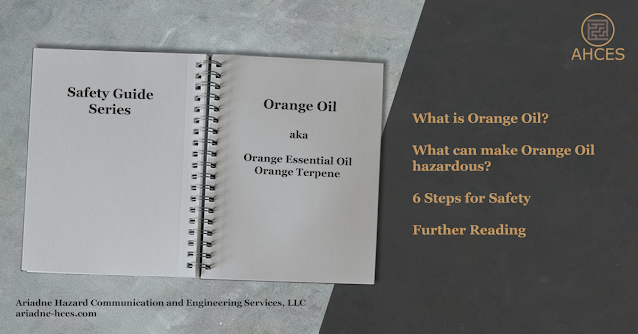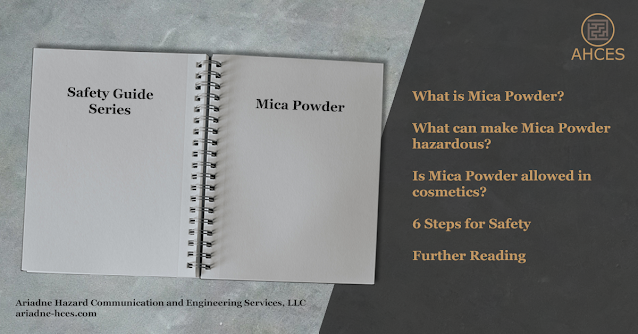Navigating Through the Labyrinth of SDS Requirements
An Introduction
to SDS Requirements
A
Safety Data Sheet (SDS) is a technical and regulatory document that is used to
describe the properties of a hazardous chemical. It is an important document
for chemical safety in the workplace.
This
article will cover SDS documents as described in the Hazard
Communication section of the Code of Federal Regulations, for the United States
of America, as part of the Occupational Safety and Health Administration
(OSHA). The full text of the Hazard Communication Standard can be found
at 29 CFR 1910.1200.
What is a
Safety Data Sheet (SDS)?
The
OSHA Definition of a Safety Data Sheet is:
Safety data sheet (SDS) means written or printed material concerning a hazardous chemical that is prepared in accordance with paragraph (g) of this section. - 29 CFR 1910.1200(c) “Safety data sheet (SDS)”
Paragraph
(g) describes the contents of an SDS and the responsibilities of the different
parties in the supply chain, including manufacturers/importers, distributors,
and end-users.
What About a
Material Safety Data Sheet? What is the Difference between an MSDS and an SDS?
The
material safety data sheet used a now outdated format that had been used for
the same purpose of describing the properties and risks of a hazardous
chemical. The change in format and name took place with the Hazard
Communication Standard revisions which went into effect May 25,
2012. OSHA allowed for an adjustment period of over three years, with SDS
documents needing to be provided in place of MSDS documents by June 1, 2015, as
explained in a standard interpretation
letter. The change to the SDS format brought the United States regulations
in line with the Global Harmonized Standard (GHS).
What is a
Hazardous Chemical?
The
OSHA Definition of a Hazardous Chemical is:
Hazardous
chemical means any chemical which is classified as a physical
hazard or a health hazard, a simple asphyxiant, combustible dust, pyrophoric
gas, or hazard not otherwise classified. - 29 CFR 1910.1200(c) “Hazardous
chemical”
In
simpler terms, for the purposes of workplace safety, a hazardous chemical is a
substance that can cause physical damage or is harmful to human health.
Who is
Responsible for Making an SDS?
Chemical
manufacturers and importers are responsible for the creation of appropriate safety
data sheets (SDS) for any hazardous chemicals they manufacture or import. A
chemical manufacturer can develop the SDS in-house or use a third-party
authoring company to develop one. A chemical importer may obtain an SDS from
their foreign manufacturing partner, though the U.S. business is responsible
for ensuring that the information is correct and is considered the responsible
part for identification and legal liability purposes.
Chemical
distributors and end-users, or any other employer that has employees
exposed to hazardous chemicals, are responsible for ensuring that a proper SDS
has been provided with each of the hazardous chemicals at the
workplace. Any employer may choose to have a new SDS developed, such as for
re-branding purposes or to generate a more general document if purchasing the
same hazardous chemical from multiple vendors.
When Does an SDS Need to Be Updated?
In
the latest regulations related to SDS by OSHA, there is no longer a mandatory
update cycle. If new, significant information on the hazards of a chemical
substance becomes known, there is a three-month period to update any effect
documents.
Note
that this only applies to US OSHA-regulated SDS documents. Mandatory update
cycles may still apply in other jurisdictions. An SDS produced in one country
may or may not be considered compliance in another country.
Overview of SDS
Sections
The
sections of the SDS come from the guidelines of the United
Nations Globally Harmonized System of Classification and Labeling of
Chemicals (GHS). The GHS calls for an SDS to be divided into sixteen (16)
sections.
Section 1:
Identification
The
product identifier is used in this section. This identifier is the name used
for the chemical other than the substance name, such as a trade name, formula
name, or common name. The product identifier on the SDS must match the product
identifier used on the corresponding hazardous chemical label.
Other
means of identification are also to be indicated in this section. This includes
product names for sales purposes or any other alternate names the chemical may
be referred to as.
The
recommended use and any restrictions on use are indicated in this section.
The
name, address, and telephone number of the manufacturer, supplier, or
responsible party must also be provided on the label.
Additionally,
an emergency contact number is also included in this section. The emergency
contact number must fit the requirements of an emergency contact as given in
the Department of Transport regulations. The emergency contact number must
monitored at all times and answered by a person who is knowledgeable of the
hazardous chemical(s) and has comprehensive emergency response information, or
has immediate access to a person who has the knowledge.
Section 2:
Hazard(s) Identification
This
section includes the classification of the chemicals, including physical
hazards, health hazards, and hazards not otherwise classified.
This
section also includes the corresponding pictograms, hazard statements, and
precautionary statements.
If
any of the substances in a mixture are of unknown acute toxicity in a ≥1%
concentration, a disclaimer statement must be included. This statement is that
the mixture contains ingredient(s) of unknown acute toxicity, with the
corresponding concentration of the ingredient(s).
Section 3:
Composition/Information on Ingredients
For
each substance that makes up a chemical, the following information is provided.
- Chemical Name
- Common Names and
Synonyms
- CAS Number and
other unique identifiers
- Impurities and
stabilizing additives that are also classified as hazardous
- Exact
Concentration or Concentration Range for all ingredients
The
presentation of this information may differ if the originator has chosen to
withhold information on one or more ingredients as a trade secret.
A Note on Trade Secrets Pertaining to SDS Composition Disclosure
The originator of an SDS may choose to withhold specific information about the identity or precise concentration of a hazardous chemical provided the following.
- There is a supported claim that the information is a trade secret.
- Information about the hazardous properties of the chemical is disclosed in the SDS.
- The SDS includes a statement that the specific information is being withheld.
- The specific information is made available to health professionals, employees, and designated representatives in accordance with the regulations.
The full information on trade secrets pertaining to safety data sheets can be found at 29 CFR 1910.1200(i).
Section 4:
First-Aid Measures
This
section includes important information for rendering first aid in the event of
exposure to the hazardous material covered by the SDS. This information
includes a description of measures to be taken according to different routes of
exposure, such as inhalation, skin contact, eye contact, and ingestion.
This
section also includes important symptoms, both acute and delayed, as well
as the signs that immediate medical attention will be needed and what
special treatment may needed in the event of exposure.
Section 5:
Fire-Fighting Measures
This
section includes important response information in the event there is a fire
involving the hazardous chemical. This information includes suitable and
unsuitable extinguishing material, specific hazards arising from the chemical
in a fire, and any special protective equipment and precautions for
fire-fighters.
Section 6:
Accidental Release Measures
This
section contains information on how to respond in the event of an accidental
release, such as a spill. This information includes precautions to be taken,
protective equipment needed, and emergency procedures. Also included are the
methods and materials needed for containment and cleanup.
Section 7:
Handling and Storage
This
section gives information about safe handling and storage practices for the
material covered by the SDS. This information includes precautions to be taken
for safe handling. This information also includes conditions for safe storage,
including incompatibilities.
Section 8:
Exposure Controls/Personal Protection
This
section gives any specific exposure limits for the hazardous chemical as given
by OSHA permissible exposure limit (PEL), American Conference of Governmental
Industrial Hygienists (ACGIH) Threshold Limit Value (TLV), and any other
exposure limit used or recommended by the chemical manufacturer, importer, or
employer preparing the SDS.
Additionally,
this section includes any appropriate engineering controls and individual
protection measures, such as personal protective equipment (PPE).
Section 9:
Physical and Chemical Properties
This
section lists all available physical and chemical properties, including but not
limited to appearance, odor, melting point, and solubility.
Section 10:
Stability and Reactivity
This
section gives information about the stability and reactivity of the covered
hazardous chemical. This includes information on the possibility of hazardous
reactions and hazardous decomposition products, as well as incompatible
materials and conditions to avoid.
Section 11:
Toxicological Information
This
section gives information both describing the toxicology of the hazardous
chemical and the numerical measures for the toxicology. Information includes
the likely routes of exposure and corresponding symptoms of exposure.
This
section also includes whether the hazardous chemical is listed in the National
Toxicology Program (NTP) Report on Carcinogens or if it has been found to be a
potential carcinogen in the International Agency for Research on Cancer (IARC)
Monographs (latest edition), or by OSHA.
Section 12:
Ecological Information
The
information in this section is not regulated by OSHA and is considered
non-mandatory for the purposes of regulatory compliance. As the information is
required to conform to other regulations, including EPA and/or DOT
requirements, it is considered good practice to include the information in the
SDS.
This
section includes ecotoxicity information, persistence, degradability,
bio-accumulative potential, mobility in soil, and any other adverse ecological
effects.
Section 13:
Disposal Considerations
The
information in this section is not regulated by OSHA and is considered
non-mandatory. As the information is required to conform to other regulations,
including EPA requirements, it is considered good practice to include the
information in the SDS.
This
section includes information about handling waste residues from the hazardous
chemical. This includes a description of waste residues, information on their
safe handling, and methods of disposal. This includes the disposal of any
contaminated packaging.
Section 14:
Transport Information
The
information in this section is not regulated by OSHA and is considered
non-mandatory. As the information is required to conform to other regulations,
primarily DOT requirements, it is considered good practice to include the
information in the SDS.
This
section includes information about any applicable transportation information
for the hazardous chemical. Please note that a hazardous material may not be
classified as hazardous for transportation purposes.
This
section includes the UN number, UN proper shipping name, transport hazard
classes, packing group, environmental hazards, and any applicable special
precautions.
Section 15:
Regulatory Information
The
information in this section is not regulated by OSHA and is considered
non-mandatory. As the information is required to conform to other regulations,
it is considered good practice to include the information in the SDS.
This
section includes any other applicable regulatory information for the hazardous chemical
and/or its ingredients. This includes listing on any disclosure lists not
covered by the other sections, such as a California Proposition 65 disclosure.
Section 16:
Other Information
This
section includes the date of preparation or last revision of the SDS. Many SDS
authors also include a list of citations and databanks utilized in the SDS
creation in this section.
Importance of Complying with SDS Requirements
Legal and
Regulatory Compliance
The
Hazard Communication Standard, which covers SDS documents, was the 2nd most
commonly cited regulation in 2022 on the federal level. OSHA does enforce the
regulations around proper communication of what chemical hazards are in the
workplace. This includes having proper SDS documents and chemical labels in place.
Minimizing Risk
and Occupational Hazards
In
addition to being legally required, SDS documents provide important information
for maintaining a safe, and therefore productive, work environment. Knowing
what hazards are present enables proper planning and safety measures to be put
into place.
Utilizing SDS Information for Risk Assessments
Performing
a risk assessment requires knowing what the risks are. An SDS provides the
majority of the information needed, containing the physical and health hazards
of a given hazardous chemical, as well as recommendations for the engineering
controls and personal protective equipment needed. Combining this basis
provided with the particular setup and needs of a given workplace allows for a
good risk assessment to be performed.
Training Employees on SDS Awareness and Understanding
Employees should be
trained on how to read an SDS, both as an OSHA requirement and general good
practice for chemical safety. This includes what information is contained in
each of the sixteen sections and the meaning of the GHS symbols.
Maintaining an SDS Binder
An
SDS Binder serves as a convenient reference location for all SDS documents for
hazardous chemicals used in the workplace. The binder can be a physical
binder or an electronic folder. With either format, the SDS documents need
to be readily available, with access unimpeded by a key or password.
Conclusion
A
safety data sheet (SDS) is an important tool for working safely with hazardous
chemicals. Understanding SDS requirements is key to implementing their proper
use in the workplace.
Learn more about the importance of OSHA even when Self-Employed, and take advantage of the official OSHA eTools to aid in compliance.







Comments
Post a Comment